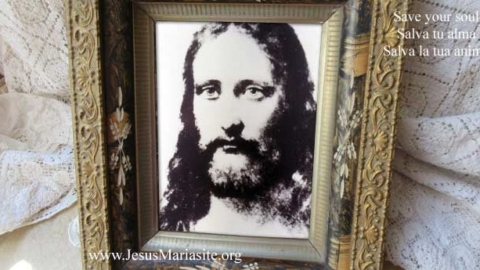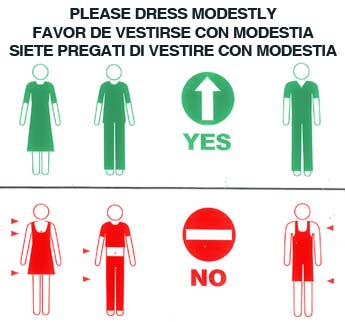In Exodus 20.2 God reveals his name to Moses:
“I am the Lord, your God, who brought you out of the land of Egypt”
The word translated as “Lord” is the famous Tetragram that Jews can not even pronounce:
“YHWH,” vocalized in different ways such as “Yahweh”. The four Hebrew letters that make it up are these: “יהוה”, Yod-he-waw-he. Remember that Hebrew is read from right to left.
In the Gospel of John, chapter 19, verses 16-22, we read:
“And they took Jesus, and carrying his own cross he went out to the Place of the Skull, in Hebrew, Golgotha, where they crucified him with two others, one on one side one on the other, and Jesus in the midst. Pilate also wrote a title and put it on the cross; it reads, “Jesus of Nazareth, King of the Jews.”
Many of the Jews read this inscription, because the place where Jesus was crucified was near the city; It was written in Hebrew, Latin and greek. The chief priests of the Jews said to Pilate: “Do not write ‘The King of the Jews’, but ‘This man said: I am the King of the Jews’.” Pilate answered, “What I have written I have written. ‘”
Despite the passage in question is very famous, the scene that took place in front of the crucified Jesus, must have been a bit different from how we have always imagined. John, perhaps, tried to emphasize this but the reader, who does not know the Hebrew language, is unable to comprehend the meaning.
The inscription mentioned by John is the famous letters “INRI”, depicted still above the crucified Jesus. The acronym, which stands for the Latin “Iesus Nazarenus Rex Iudaeorum“, means “Jesus of Nazareth, King of the Jews.”
But John specifies that the inscription was also in Hebrew. Not only that, in such an important moment, the Evangelist seems to dwell on the details seemingly insignificant:
– The fact that many of the Jews read this inscription, because the place where Jesus was crucified was near the city.
– The chief priests who come to Pilate asked to change the inscription.
– Pilate refuses to change it.
Pontius Pilate, who was an officer of the Roman Empire, probably did not understand that, unwittingly, had created a bit of embarrassment – if we want to call it that way – to the Jews who observed Jesus crucified with that inscription above the head.
Henri Tisot, Hebrew expert, turned to several rabbis to ask what was the exact enrollment of the Hebrew translation made complete by Pilate. He talks about it in his book “Eva, the woman” from page 216 to 220.
He discovered that it is mandatory grammatically, in Hebrew, to write “Jesus of Nazareth, King of the Jews.” With Hebrew letters we get “ישוע הנוצרי ומלך היהודים”.
Remember the reading from right to left.
These letters are equivalent to our “Yshu Hnotsri Wmlk Hyhudim” vocalized “Yeshua Hanotsri Wemelek Hayehudim“.
So, in getting the Latin “INRI” acronym for the Hebrew you get “יהוה”, “YHWH.”
This explains the attention that John reserves to the situation that is taking place under the crucified Jesus. At that time the Jews saw the man who they had put to death, who had claimed to be the Son of God, by the name of God, the Tetragrammaton unpronounceable, engraved above his head.
It could not be good that YHWH was written there, visible to all, and tried to persuade Pilate to change the incision. That’s the phrase of the Roman procurator “What I have written I have written” acquires a meaning much deeper.
It sounds incredible? Do you think that Jesus had prophesied exactly this moment. In John 8:28 we read:
“So Jesus said,” When you have lifted up the Son of Man, then you will know that I Am “
To “raise” Jesus means the crucifixion. “I Am” alludes to the name that God revealed to Moses in Exodus 3:14:
“God said to Moses,” I AM THAT I AM. ” He added, “Thus you shall say to the Israelites: ‘I AM has sent me to you'”
Author: Daniele Luciano



















 Pray for the Church, its Hierarchies, the validly ordained and consecrated during this time of confusion and apostasy. Do not fall into the trap of division, even with apparent good reasons. Turn your eyes to the lives of saints, such as St. Martin de Porres, St. Padre Pio of Pietrelcina, the former discriminated against and the latter fought by the same institution. Let their behavior in adversity be an example for you to follow…
Pray for the Church, its Hierarchies, the validly ordained and consecrated during this time of confusion and apostasy. Do not fall into the trap of division, even with apparent good reasons. Turn your eyes to the lives of saints, such as St. Martin de Porres, St. Padre Pio of Pietrelcina, the former discriminated against and the latter fought by the same institution. Let their behavior in adversity be an example for you to follow…

 “The Church is God’s house. It is forbidden for men to enter here with bare arms and wearing shorts. It is forbidden for women to enter wearing trousers, bare headed, with short, low-necked or sleeveless dresses.”
“The Church is God’s house. It is forbidden for men to enter here with bare arms and wearing shorts. It is forbidden for women to enter wearing trousers, bare headed, with short, low-necked or sleeveless dresses.”



 “Parents, correct the ways if your family, have much dialogue with your children, make time to listen to them as many homes are being lost due to lack of love, dialogue, understanding and most specially for not inviting God. Take God back into your homes, pray my Holy Rosary, as the family that prays together stays together.”
“Parents, correct the ways if your family, have much dialogue with your children, make time to listen to them as many homes are being lost due to lack of love, dialogue, understanding and most specially for not inviting God. Take God back into your homes, pray my Holy Rosary, as the family that prays together stays together.” 




 January 31, 2022 "Heavenly Father, today, I surrender to You my heart. Help me to be Your instrument in the world. Cover me with the Precious Blood of Your Divine Son. Guard me against all evil. Protect me from any evil plan Satan may have for me today. Clothe me in Your Divine Will. Amen"
January 31, 2022 "Heavenly Father, today, I surrender to You my heart. Help me to be Your instrument in the world. Cover me with the Precious Blood of Your Divine Son. Guard me against all evil. Protect me from any evil plan Satan may have for me today. Clothe me in Your Divine Will. Amen" October 29, 2022 - "Most Holy Mother of God, Mary, Protectress of the Faith, shelter my faith in the refuge of your Immaculate Heart. Therein, protect my faith from any marauder. Expose to me the threats to my faith and help to overcome them. Amen"
October 29, 2022 - "Most Holy Mother of God, Mary, Protectress of the Faith, shelter my faith in the refuge of your Immaculate Heart. Therein, protect my faith from any marauder. Expose to me the threats to my faith and help to overcome them. Amen" "O Hearts of Jesus and Mary; I consecrate myself, I consecrate my family and the whole world, to your Most Beloved Hearts. Listen to the supplication which I making to you and accept our hearts in Yours, to be delivered and protected we, the whole world, from all evil and all sin. May the protection of your Two Hearts be refuge, strength, and protection, in the daily spiritual struggles. That the power of your Two Hearts irradiates the world so that it is protected from evil and sin. We willingly consecrate ourselves and consecrate all mankind to your Hearts; sure and confident, for your Great Mercy, to obtain the victory over the forces of evil in this world, and the eternal Glory in the Kingdom of God. Amen"
"O Hearts of Jesus and Mary; I consecrate myself, I consecrate my family and the whole world, to your Most Beloved Hearts. Listen to the supplication which I making to you and accept our hearts in Yours, to be delivered and protected we, the whole world, from all evil and all sin. May the protection of your Two Hearts be refuge, strength, and protection, in the daily spiritual struggles. That the power of your Two Hearts irradiates the world so that it is protected from evil and sin. We willingly consecrate ourselves and consecrate all mankind to your Hearts; sure and confident, for your Great Mercy, to obtain the victory over the forces of evil in this world, and the eternal Glory in the Kingdom of God. Amen" "O Virgin of Carmel, may the power of your Holy Scapular take away from me the enemy of my soul; bless me, Mother of Carmel, and deliver me from all evil and danger in this world. I ask you O Mother, that in the hour of my death, your Holy Scapular frees me from the fury of the devil and in the eternity, of the eternal fire. Amen"
"O Virgin of Carmel, may the power of your Holy Scapular take away from me the enemy of my soul; bless me, Mother of Carmel, and deliver me from all evil and danger in this world. I ask you O Mother, that in the hour of my death, your Holy Scapular frees me from the fury of the devil and in the eternity, of the eternal fire. Amen" 
 "Oh Jesus of Divine Mercy, hear my pleadings to you, for I am here to do your Will"
"Oh Jesus of Divine Mercy, hear my pleadings to you, for I am here to do your Will" "O glorious St. Joseph! by your profound humility, by your unalterable meekness, by your invincible patience, by your angelic purity and perfect fidelity that made you a timely imitator of the virtues of Jesus and Mary, I ask you to console me in all my sorrows, to guide me in all my doubts, to defend me in all temptations, to deliver me from all spiritual and material dangers; to extend your arm against all my visible and invisible enemies, breaking and destroying all the snares and barriers that they tend and arm against me. Amen"
"O glorious St. Joseph! by your profound humility, by your unalterable meekness, by your invincible patience, by your angelic purity and perfect fidelity that made you a timely imitator of the virtues of Jesus and Mary, I ask you to console me in all my sorrows, to guide me in all my doubts, to defend me in all temptations, to deliver me from all spiritual and material dangers; to extend your arm against all my visible and invisible enemies, breaking and destroying all the snares and barriers that they tend and arm against me. Amen"  "Oh, blessed Saint Michael, protect us from the attacks and snares of the evil spirits because you know full well that we are poor mortals, fragile and weak, in need of the Mercy of God and of your protection to fulfill the mission that Heaven has commissioned to us. Oh, Saint Michael, may your victorious cry: “who is like God? no one is like God”, suppress and cast into Hell satan and all the evil spirits who prowl about the world seeking the destruction of souls. Amen"
"Oh, blessed Saint Michael, protect us from the attacks and snares of the evil spirits because you know full well that we are poor mortals, fragile and weak, in need of the Mercy of God and of your protection to fulfill the mission that Heaven has commissioned to us. Oh, Saint Michael, may your victorious cry: “who is like God? no one is like God”, suppress and cast into Hell satan and all the evil spirits who prowl about the world seeking the destruction of souls. Amen" Most sweet Jesus, redeemer of the human race, look down upon us, humbly prostrate before your altar. We are yours and yours we wish to be; but to be more surely united with you, behold each one of us freely consecrates himself today to your most sacred heart. Many, indeed, have never known you, many too, despising your precepts, have rejected you. Have mercy on them all, most merciful Jesus, and draw them to your sacred heart. Be you king, O Lord, not only of the faithful who have never forsaken you, but also of the prodigal children who have abandoned you; grant that they may quickly return to their father’s house, lest they die of wretchedness and hunger. Be you king of those who are deceived by erroneous opinions, or whom discord keeps aloof, and call them back to the harbor of truth and unity of faith, so that soon there may be but one flock and one shepherd. Be you king also of all those who sit in the ancient superstition of the Gentiles, and refuse not you to deliver them out of darkness into the light and kingdom of God. Grant, O Lord, to your Church, assurance of freedom and immunity from harm; give peace and order to all nations, and make the earth resound from pole to pole with one cry: Praise to the divine heart that wrought our salvation; to it be glory and honor forever. Amen.
Most sweet Jesus, redeemer of the human race, look down upon us, humbly prostrate before your altar. We are yours and yours we wish to be; but to be more surely united with you, behold each one of us freely consecrates himself today to your most sacred heart. Many, indeed, have never known you, many too, despising your precepts, have rejected you. Have mercy on them all, most merciful Jesus, and draw them to your sacred heart. Be you king, O Lord, not only of the faithful who have never forsaken you, but also of the prodigal children who have abandoned you; grant that they may quickly return to their father’s house, lest they die of wretchedness and hunger. Be you king of those who are deceived by erroneous opinions, or whom discord keeps aloof, and call them back to the harbor of truth and unity of faith, so that soon there may be but one flock and one shepherd. Be you king also of all those who sit in the ancient superstition of the Gentiles, and refuse not you to deliver them out of darkness into the light and kingdom of God. Grant, O Lord, to your Church, assurance of freedom and immunity from harm; give peace and order to all nations, and make the earth resound from pole to pole with one cry: Praise to the divine heart that wrought our salvation; to it be glory and honor forever. Amen.